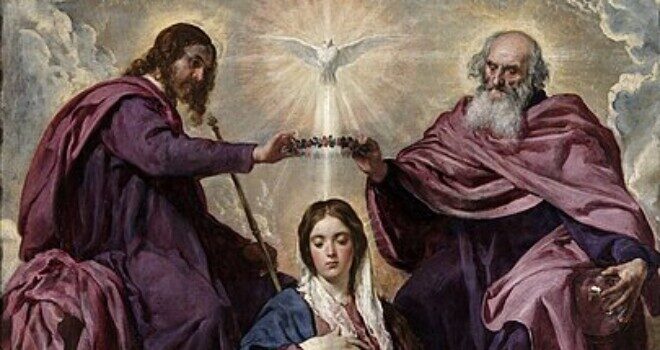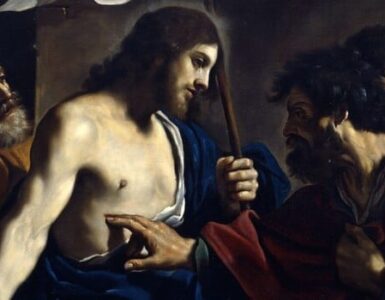In 1422, a young Franciscan novice was distraught to realize that as a Franciscan, he could no longer bring a crown of roses to a statue of Our Lady every day, a habit he had cultivated since childhood. As he contemplated leaving the order for the sake of this devotion, the Mother of God appeared to him and gave him a new way to construct her daily crown: seven decades of a rosary, each dedicated to Our Lady’s joys: The Annunciation, Visitation, Nativity, Adoration of the Magi, Finding Jesus in the Temple, the Resurrection, and Our Lady’s Assumption and Crowning as Queen of Heaven and Earth. This alternate form of the Rosary has become known as the Franciscan Crown and was so deeply beloved that it bears the distinction of being the devotion with the most indulgences granted to its use.
Fittingly, the crowning of Mary as Queen of Heaven is the crescendo that concludes both the Dominican (traditional) and Franciscan rosaries. Christians East and West have recognized Our Lady as our Queen, the mother of Christ our King, since the earliest centuries of the Church. Church Fathers called Mary “Our Lady” even before the Council of Ephesus clarified that she is the Mother of God. After that council, the idea that Mary is the Queen over all other queens exploded, resulting in a rich artistic and prayer tradition depicting Our Lady being crowned queen, sitting upon a throne in heaven.
At my wedding, which was conducted according to the Eastern (Byzantine) marriage rite, I too was crowned a queen. There is a beautiful moment in the Eastern marriage rite where the husband and wife are crowned with marriage crowns tied together with a long white ribbon. As the crowns were placed upon our heads, the choir chanted a hymn celebrating the motherhood of the Virgin Bride: Mother Mary. “Rejoice, O Isaiah! The Virgin is with child, and shall bear a son Emmanuel, who is both God and Man, and Orient is His Name, whom magnifying we call, the Virgin blessed…”
It is a magnificent moment where the husband and wife are called to accept the crowns of our vocation. The crowns are both joyful and bittersweet: we are vested with the authority of father and mother of our newly established household, and we are crowned with our crowns of martyrdom. Our vocation demands that we die to ourselves and to our freedom as single people and instead take up the cross of matrimony—sometimes light, sometimes heavy. My marriage crown sits in a case in my dining room, next to my husband’s crown. One day, we shall carry those crowns to the feet of the King of Kings and His mother, the Queen of Queens.
Many orders of nuns also receive crowns on the day of their profession. There are Capuchins who are crowned with flowers, Poor Clares who are crowned with thorns. I have seen Therese of Lisieux’s crown of roses, lovingly preserved with her gorgeous hair at her monastery. Saint Hildegard von Bingen, a twelfth century Benedictine abbess and Doctor of the Church, crowned her nuns with gold crowns. Medieval German nuns wore a linen circlet embroidered with crosses around their heads over their veils as part of their habits.
This “nun’s crown” is given as part of a coronation ceremony during her profession, much like my marriage crown was given to me during my vows of marriage. And, just like my marriage crown, the nun’s crown is also the crown of her martyrdom, as she dies to the world and offers herself entirely to God through her vocation.
My marriage crown and a nun’s professional crown both unite us even more closely to the Queen of Heaven. Our Lady is, of course, the perfect queen, just as she is the perfect mother and the most perfect virgin. Both nuns and lay mothers are called to wear our vocational crowns in emulation of the Queen of Queens. After all, the Queen of Heaven is the model and source for both of our vocations. In her perpetual virginity, Mary is the inspiration for over two thousand years of women offering their virginity to God in the holy vocation of religious life. And while the Mother of God did not originate the vocation of married life and physical motherhood, she perfected it.
Thus, nuns, wives, and mothers are all called to be little queens for those in our families, communities, and local Church, representing the great Queen of Heaven herself. Our queenship is not a glamorous one; like the Queen of Heaven, our vocations call us to faithfully fulfill the same sort of quiet, often unrecognized and even un-thanked service that she rendered day in and day out. But we too wear a Marian crown, and each day, as we lovingly carry out our vocations, we can lay that crown at her feet and dedicate our vocations to Our Lady, Queen of Heaven and Earth. For the Almighty has done great things for us, too. And so, just like our queen and mother, we should constantly proclaim, “My soul proclaims the greatness of the Lord, and my spirit rejoices in God my savior.”
Velázquez, D. (1641-44). Coronation of the Virgin [oil on canvas]. Retrieved from Wikimedia Commons.











